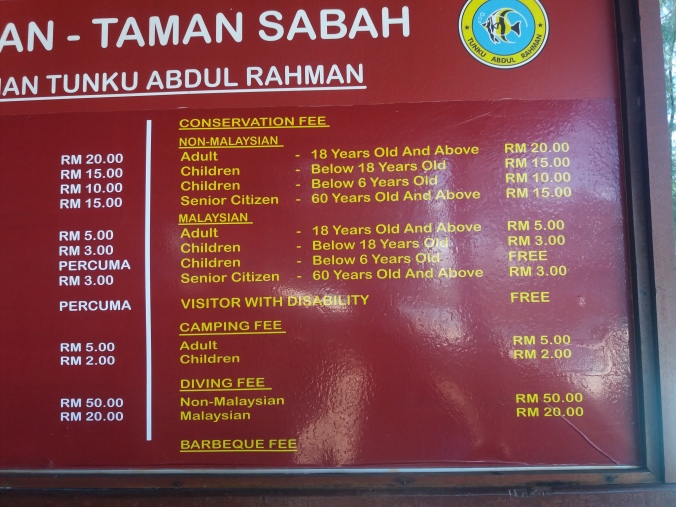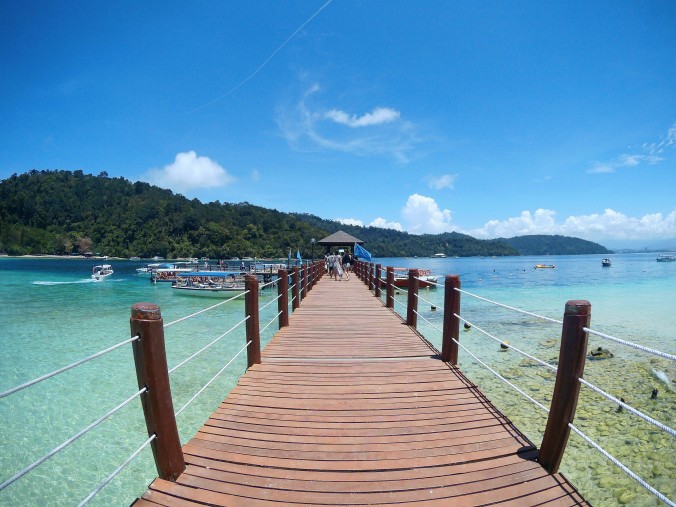Kota Kinabalu is the capital of the East Malaysian state of Sabah in the island of Borneo. Having been granted a city status in 2000, it’s one of the busiest and most visited places in Malaysia. Nevertheless, KK, as it is affectionately called, still retains its charm. Until 1967, KK was known as Jesselton until it was named after Mt. Kinabalu that towers over the town.
I’m spending the least time in Malaysia for this trip and I must admit that I just included it since Kota Kinabalu offered me the cheapest flight out of the Philippines. A quick check showed me that the city’s highlights include the islands, and as a girl who was raised in the Philippines and had seen Palawan and Boracay, I didn’t have high expectations from our neighboring countries in terms of beaches.
Having minimum expectations, KK completely blew my mind! I only had a full day to explore so I chose to visit the islands of Tunku Abdul Rahman National Park, leaving Mt. Kinabalu and other sights for my return in May.
Island hopping
All tours depart from Jesselton Point. I was greeted by numerous travel agencies offering transfers to the islands – Manukan, Mamutik, Sapi, and Sulug. They have the same prices and rates depend on the number of islands to be visited:
- 2 islands – RM 33
- 3 islands – RM 43
- 4 islands – RM 53
In addition to this, there is also RM7 for tariff and service charges.
Each company has a schedule of transfers from one island to another so I had to arrange my preference with the ticket provider. As there are several schedules per day, I was still free to decide how long I wanted to stay on each island. Here’s a sample itinerary to visit three of them:
09:00 – 09:30 Transfer to Mamutik
09:30 – 11:00 Mamutik Island
11:00 – 11:10 Transfer to Sapi
11:10 – 13:00 Sapi Island
13:00 – 13:10 Transfer to Manukan Island
13:10 – 15:00 Manukan Island
15:00 – 15:30 Transfer back to Jesselton Point
Upon arrival on the first island, a conservation fee of RM20 (foreigners) has to be paid. This is valid on all the other islands so make sure to keep the receipt. Other fees are also shown below:

Manukan Island


Manukan, with 200,000 annual visitors, is the most famous island in Sabah. It is also the most developed in TARP, offering a wide range of hotel accommodations. With 1.5 km of sandy beach, finding a secluded spot is less challenging than in Sapi Island.
Inspite of the well-developed amenities, the island still protects its natural environment. The beach is lined with trees, offering shade from the harsh heat of the midday sun. There is a also a kilometer-long jungle trail that navigates through the thick forest and brings adventurous souls to the other end of the island.
Sapi Island


This may be just a third of the size of Manukan island, but I was mesmerized by its beauty even before I stepped on its wooden platform!
Sapi is best known for the Coral Flyer, the longest island-to-island zipline in the world at 235 meters (RM64). But even if you’re not up for this adventure, it has 200 m of shoreline where you can laze around. It also offers the perfect spot for snorkeling with its abundant marine biodiversity – it was easy to spot a huge school of fish even from the jetty. Wildlife out of the water is also just as amazing – it’s typical to spot monitor lizards roaming around the island
Mamutik Island

One of the least touristic among the islands, Mamutik offers tranquility from those who are wary of the crowds that flock Sapi and Manukan. There are several reasons why it is less frequented by tourists: (1) fragments of corals line the shore instead of fine sand, (2) the coral reef is less stunning than its neighboring islands, and (3) the waves can be a bit rough. However, it offers one thing that Manukan cannot – camping. Since there is no hotel on the island, camping is allowed upon payment of RM5 fee. Tents can also be rented for RM30.
Each island of TARP has its own charm and I’m glad that I ended up visiting the three of them. I couldn’t wait to return!
WOW!
This makes me wanna go to KK as well! 🙂
Panlaban sa Pinas ah 😀
LikeLiked by 1 person